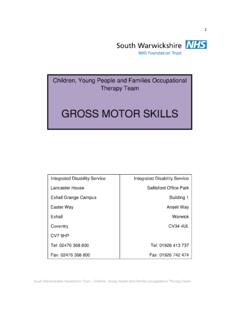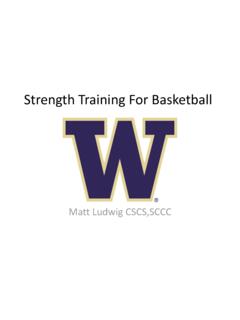Transcription of CORE STABILIZATION EXERCISE
1 CORE STABILIZATION EXERCISE . Vincent J. Hudson, PhD, DPT, MBA, ATC. Chief Operating Officer OAA Orthopaedic Specialists Allentown, PA. Core STABILIZATION EXERCISE Stepping Back What are the goals? What is the value? Is it Sport Specific or Generic? Is it preventative or rehabilitative? Are there contraindications? Do all athletes benefit from these exercises? Are they time efficient? Core STABILIZATION EXERCISE EVERYBODY is DOING IT! . Core STABILIZATION EXERCISE What is Core STABILIZATION ? Abdominal exercises? Lumbar exercises? UE exercises? LE exercises? Muscle specific? Sport specific? Weight reduction? Pilates? Yoga? Tai Chi? Voodoo? Core STABILIZATION EXERCISE Biomechanical Facts Lumbar spine has 6 degrees of freedom 3 rotational and 3 translational stability achieved by symmetry in these degrees stability is the muscles acting in constant adjustment of co contraction Poor stability will result in extreme joint loads to the lumbar spine Core STABILIZATION EXERCISE Biomechanical Requirements Flexibility must have the capacity to co contract the stabilizing forces to avoid loading the joints Strength must have the ability to recruit sufficient forces to maintain a stabilizing (neutral).
2 Effect upon the joints Balance all stabilizing forces must have general equality in both strength and flexibility Endurance fatigue of stabilizers mimic weakness Think about your athlete's training regimen Are they equal? Core STABILIZATION EXERCISE Unequal Forces Produce Drastic Effects Core STABILIZATION EXERCISE Core Standards Theoretical basis of core training is to increase the recruitment efficiency of the smaller, deeper stabilizing' muscles around the hip and pelvis The ability of the core muscles to work in an efficient and coordinated fashion to maintain correct alignment of the spine and pelvis while the limbs are moving Athlete must be trained to fire these muscles simultaneously maintaining a neutral core'. You're actually only as strong as your weakest muscular link Defining a link Core STABILIZATION EXERCISE The stars of the show tend to be the transverse abdominus, multifidus and gluteus medius Core STABILIZATION EXERCISE Core Principles Whole body approach involves simply choosing exercises that require the core muscles to maintain correct posture and alignment while the arms and/or legs move.
3 Proprioception/NMF in firing the Core Muscles'. Athlete prone, manual approach to educate muscles to fire Athlete supine, manual approach to educate muscles to fire Must promote flexibility to all muscles attached to the pelvis Abd, lumbar ext, hip f/e/add/abd/ir/er Athlete must demonstrate ability to control and maintain this posture Core STABILIZATION EXERCISE Finding Neutral Stand normally in front of a mirror with your hands on your hips, just below your waist. Allow your low back to arch so your stomach juts forward, and your buttocks stick out; notice how your hands rotate forward. Tighten the muscles around your stomach and buttocks so your low back becomes very flat; notice how your hands rotate backward. Now go halfway between the forward and back positions. Keeping your pelvis in this neutral position, stand tall with your ears and shoulders lined up over your hips. Practice finding neutral spine in three positions: standing, sitting, and lying on your back with your knees bent.
4 Once you can find neutral spine in each position, you can maintain good posture for daily activities and for EXERCISE . Promote this concept to positioning a neutral spine in sports specific positions Core STABILIZATION EXERCISE STEP 1 Creating Needs List . Examine PMH. Evaluate Static Posture Note pelvic tilt, forward head, hip elevation, foot placement Evaluate Dynamic Posture Observe them walk and/or jog Evaluate Individual Flexibility Sit and reach Supine hamstring Prone hip flexors Hip IR and ER in both Prone (neutral) and supine (hip F 90. degrees). Prone lumbar extension extend elbows without pelvic elevation? Muscular Atrophy Observation/Measurement Core STABILIZATION EXERCISE Needs Intervention Are there any postural asymmetry noted? If so, how will this effect your goals of core stability ? Course of action? Are there flexibility asymmetry noted If so, how will this effect your goals of core stability ?
5 Course of action? Are there any muscular atrophy noted? If so, how will this effect your goals of core stability ? Course of action? Core STABILIZATION EXERCISE Research 1. Loads away from core increase muscle requirements to maintain stability , while kyphotic posture creates greater challenges on stability than lordotic. 2. No single muscle dominated in the enhancement of spine stability , and their individual roles were continuously changing across tasks. Clinically, if the goal is to train for stability , enhancing motor patterns that incorporate many muscles rather than targeting just a few is justifiable. 3. Instantaneous stability increased with well coordinated effort, muscle activation, and compression, but decreased when subjects had poor technique. The way the Bodyblade is used may either enhance or compromise spine stability . Associated lumbar compressive forces may be inappropriate for some people with compression intolerant lumbar spine pathology.
6 4. A general EXERCISE program reduced disability in the short term to a greater extent than a STABILIZATION enhanced EXERCISE approach in patients with recurrent nonspecific low back pain. STABILIZATION exercises do not appear to provide additional benefit to patients with sub acute or chronic low back pain who have no clinical signs suggesting the presence of spinal instability. 5. The assumption that the use of an EXERCISE ball will always create a greater challenge for the musculoskeletal system was not supported by the findings of this study. Likewise, in a healthy, young population, there does not appear to be any training advantage to performing extensor exercises on a ball versus a mat. However, in a rehabilitation scenario, these exercises performed on a ball could reduce low back loading and hence reduce the potential for re injury. 6. Post fatigue, the normalized mean IEMG for both exercises increased significantly for LRA and URA muscles but not for the EO.
7 Fatiguing EXERCISE results in the LRA and URA being more highly activated. Core STABILIZATION EXERCISE References 1. El Rich & Shirazi Adl, Effect of load position on muscle forces, internal loads and stability of the human spine in upright postures. Comput Methods Biomech Biomed Engin. 2005 Dec;8(6):359 68. 2. Kavcic, Grenier & McGill. Determining the stabilizing role of individual torso muscles during rehabilitation exercises. Spine. 2004 Jun 1;29(11):1254 65. 3. Mooreside, Vera Garcia & McGill. Trunk muscle activation patterns, lumbar compressive forces, and spine stability when using the bodyblade. Phys Ther. 2007. Feb;87(2):153 63. 4. Koumantakis, Watson & Oldham. Trunk muscle STABILIZATION training plus general EXERCISE versus general EXERCISE only: randomized controlled trial of patients with recurrent low back pain. Phys Ther. 2005 Mar;85(3):209 25. 5. Drake, Fischer, Brown & Callahan.
8 Do EXERCISE balls provide a training advantage for trunk extensor exercises? A biomechanical evaluation. J Manipulative Physiol Ther. 2006 Jun;29(5):354 62. 6. Robison, Lees & Barton. Electromyographic investigation of abdominal exercises and the effects of fatigue. Ergonomics. 2005 Sep 15 Nov 15;48(11 14):1604 12. Core STABILIZATION EXERCISE Lab Part I. 1. Separate into groups and evaluate Posture (static and dynamic), asymmetry in flexibility and movement 2. Establish Neutral Core STABILIZATION EXERCISE Which Exercises? Should be initially generic > Progressed to sport specific Why have a basketball player throwing a baseball? Should work from large/multiple muscles to small/individual muscles Fatiguing of individual muscles early will create an imbalance and asymmetry in the final result Every Athlete has DIFFERENT needs Core STABILIZATION EXERCISE Abdominal crunch Abdominal crunches are a classic core EXERCISE : Lie on your back and place your feet on a wall so that your knees and hips are bent at 90.
9 Degree angles. Tighten your abdominal muscles. Raise your head and shoulders off the floor. To avoid straining your neck , cross your arms on your chest rather than locking them behind your head. Hold for three deep breaths. Return to the start Permission Mayo Foundation position and repeat. Core STABILIZATION EXERCISE Bridge To work various core muscles in combination, try a bridge: Lie on your back with your knees bent (A). Keep your back in a neutral position, not arched and not pressed into the floor. Avoid tilting your hips. Tighten your abdominal muscles. Raise your hips off the floor until your hips are aligned with your knees and shoulders (B). Hold for three deep breaths. Return to the start position and repeat. Permission Mayo Foundation Core STABILIZATION EXERCISE Segmental rotation Segmental rotation is another way to EXERCISE your core muscles: Lie on your back with your knees bent and your back in a neutral position.
10 Tighten your abdominal muscles. Keeping your shoulders on the floor, let your knees fall slowly to the left (A). Go only as far as is comfortable. You should feel a stretch, but no pain. Hold for three deep breaths. Return to the start position. Repeat the EXERCISE to the right (B). Permission Mayo Foundation Core STABILIZATION EXERCISE Quadruped This core EXERCISE is called the quadruped: Start on your hands and knees. Place your hands directly below your shoulders, and align your head and neck with your back (A). Tighten your abdominal muscles. Raise your right arm off the floor and reach ahead (B). Hold for three deep breaths. Lower your right arm and repeat with your left arm. Raise your right leg off the floor (C). Tighten your trunk muscles for balance. Hold for three deep breaths. Lower your right leg and repeat with your left leg. For added challenge, raise your left arm and your right leg at the same time (D).

